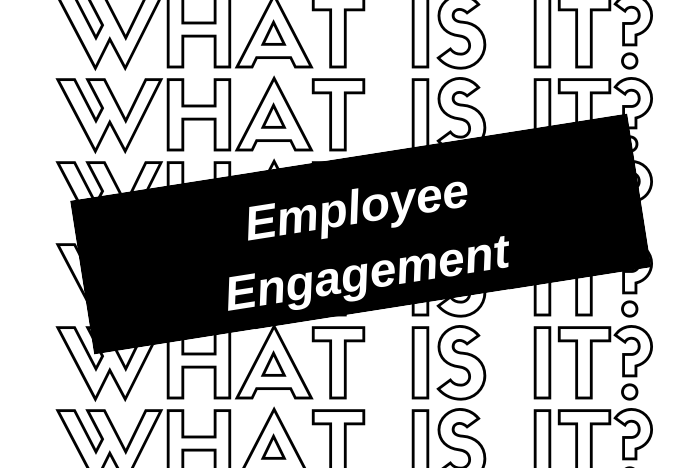“Employee engagement” has become such a common term that it’s easy to assume everyone knows exactly what it means. The words have a positive ring, for sure. (Most of us associate engagement with marriage and that’s a pretty happy time.) But what exactly does engagement mean at work? And how is it related to other similar phrases, such as employee satisfaction, employee experience, culture, and the rest?
I have dedicated the past 20 years of my career to employee engagement. As a result of being deep in it for so long, it’s easy for me to forget how confusing this language and concept can be for someone who doesn’t have that level of exposure.
If you’re not sure what this term really means or why it matters, this post is for you. Please know that you aren’t alone in your confusion.
In a nutshell, employee engagement is the connection between how an employee feels about their work experience and their performance on the job.
Employee engagement is an important concept that should be incredibly helpful to any organization or leader who cares about helping employees perform their best at work. But the idea was hijacked years ago by consultants and technologists who are more interested in selling you products than ensuring you understand how it works.
Let’s start by clearing up a few things.
Employee engagement is NOT a survey. Although businesses do use surveys to measure it.
Employee engagement is NOT a buzzword. It can feel that way but don’t be fooled. This is important work.
Employee engagement is NOT a fad. This work isn’t going anywhere. We are just getting started.
Enough about what employee engagement is not. Let’s dig into what it is and what you need to do about it.

Employee Engagement Theory: Where It All Began
Over the past 30 years, the concept of employee engagement has become a central tenet in any discussion about workplace performance and culture. Today, people discuss engagement so commonly that it’s easy to assume that everyone knows what it is and how it works.
This is certainly not the case. While we have come to accept that employee engagement is a generally positive thing that we should want more of in our organizations, when you dig a little deeper, a real lack of clarity emerges.
The key reason for this is that employee engagement is an abstract concept. Employee engagement isn’t a tangible, concrete thing that is easy to identify and measure like sales revenue or customer retention.
Engagement is a framework made up by academics and consultants to help us measure and talk about things that happen in the workplace that are hard to understand individually–things like feelings and motivations.
The employee engagement idea was first brought to life in December 1990 by Boston University professor William Kahn. He was the first to publish research using the concept of “engagement” at work. The first sentence from his 1990 paper captures the challenge and promise of this work and why it’s still relevant 30 years later.
“This study began with the premise that people can use varying degrees of their selves, physically, cognitively, and emotionally, in work role performances, which has implications for both their work and experiences.”
Kahn put this work into motion. What followed has been an avalanche of research and tools for measuring and understanding employee engagement. The Gallup Organization also played a vital role in the popularization of the employee engagement by introducing their Q12 measure of engagement and using that as a foundation to benchmark employee engagement levels globally over the past two decades.
Thanks to Kahn and the other early pioneers, we have a more profound understanding of how the employee’s experience of work drives their performance, morale, loyalty, and more.
Ironically, what hasn’t emerged over the past 30 years is a common definition for employee engagement. There are nearly as many definitions of employee engagement as there are researchers and consultants. So let’s turn our attention to that next.
Employee Engagement Definition
As someone who’s been working in the field for well over a decade now, one of the most perplexing things about the work is the lack of a clear standard definition.
Consider that some estimate that organizations globally are spending over $6 billion a year on technology to improve engagement. That’s just the technology spend. The overall investment in initiatives and programs is probably two to three times that number.
All for something that those same organizations often can’t clearly define.
This is baffling. Getting clear on definition is crucial for a variety of reasons, not the least of which is that definition is the first step of measurement. If we hope to measure our progress toward creating a more engaged workplace and quantify how it impacts organizational results, we must have an explicit definition for employee engagement.
Can you imagine an organization investing immense time and energy in the “financial health” of the organization without being crystal clear on what that meant?

Even at a personal level, the need for definition is clear. Nearly every person I know has at one point told me that they were trying to get “healthier.” That same thing has been true for me.
If improving your health is a goal, what exactly does that mean? If you don’t define what that means for you, how can you ever know if you are making progress?
For one person, health might mean weight loss. For another, it might mean stopping destructive behaviors like smoking or eating fried foods. Someone else might define it as getting 30 minutes of physical activity each day.
Only when you clearly define it can you effectively go to work on both measuring it and making intentional progress toward your objective.
Much like health, employee engagement is a broad concept that can mean a lot of things. Before starting your work to improve engagement, it is vital that you clearly articulate a definition.
The definition for your organization may be slightly different than the definition at another organization. The important thing is that it is articulated clearly in a way that can drive both action and measurement.
Below is the definition of employee engagement I use:
ENGAGEMENT is the degree to which an employee is both willing and able to perform to their potential.
It’s a simple definition. The outcome of engagement is high performance and the work of engagement is about facilitating the employee’s willingness and ability to be at their best at work.
A definition like this, while still broad, helps to clarify what this work is about and why it matters. It can also help you focus on what and how to measure your progress.
You will know that you have a clear definition of employee engagement when you (and the other leaders in your organization) have no issue explaining what it is and precisely why it’s essential to achieving your organization’s objectives.
What Drives Employee Engagement?
A definition helps us clarify the meaning of the term, but most conversations about employee engagement focus on a different question: “How does it work?” If we want to improve or enhance this thing, where should we focus?
Fortunately, Gallup, the Great Place to Work Institute, American Psychological Association (APA), and many in the academic community have been measuring employee engagement for decades. Their research provides us with rich insights into how employees experience work and what motivates them to higher performance.
Regardless of what research or data you look at regarding employee engagement, you are likely to find some of the following factors listed as significant factors or “drivers” for employees:
- Feeling valued
- Trust
- Caring
- Appreciation
- Belonging
The more employees experience these things at work, the more likely they are to be engaged.
What jumps out from this list is how relational each of these factors is. They sound more like what you would expect to be drivers of a healthy relationship than work. What these research findings reveal is that employees experience work in the same way they do any other meaningful relationship in their lives. When the relationship isn’t working or healthy, they are less likely to be or do their best.
Most organizations treat work like a contract with the employee rather than a relationship. In this way of thinking, employees receive pay and benefits in exchange for their work effort, and most management efforts are oriented around enforcing compliance with that contract.
Policy manuals, job descriptions, and performance appraisals are all management tools designed to help enforce the contract. The problem is that they do little to foster a healthy relationship with the employee, which leads to decreased employee engagement and higher turnover.
To create an experience of work that is engaging for employees, we need to embrace that work is a relationship for employees. This doesn’t mean that we throw out the policies or performance processes, just that we approach them in the spirit of fostering relationships.
That means designing management and team processes that encourage feelings of belonging, trust, caring, and appreciation. In the next section, we turn our attention to the specific strategies and practices that will most effectively help you to accomplish this.
Employee Engagement Strategies: How to Improve Employee Engagement
Improving employee engagement requires a plan. And that plan will need to take into account the needs of the people you lead, the goals of the organization, and your personal aspirations.
To create an effective strategy, know your people and engage with them to create the best course of action. Your goal should be creating a work experience that feels good to employees so that they can do better work. What this looks like will be different for every team and every organization.
The single most powerful strategy for improving employee engagement is to talk to your teams about their experience at work and find opportunities where you could work together to make that experience better. Start with four simple steps:
-
-
- Check in with your people individually, as a group, or both. Ask about their experience and how it could be better.
- Listen intently and ask follow-up questions.
- Clarify what matters most and together identify what actions employees and managers should take to have the greatest positive impact.
- Take action to make things better.
-
For large groups, you might need to use tools like employee surveys or focus groups to check-in and listen to feedback, but the fundamentals of the process are always the same. Ask, listen, identify the issue, and take action. Rinse and repeat over and over forever.
If you are married or are in a serious relationship of any sort, you already know how vital this process is to ensure the relationship stays healthy. It’s when you quit checking in with one another that relationships tend to start cracking and falling apart. The same is true at work.
Make this process the foundation of your engagement strategy. It will ensure that you are engaged in an ongoing conversation with your people about how to make the work experience better. And if you do nothing beyond just this simple process, you will have taken a huge step to improve engagement on your team. This will result in both better performance and higher retention.
Employee Engagement Articles
Hungry for more reading that will help you deepen your knowledge of how to engage your employees? Here’s a short list to get you started.
- How the Need to Belong Influences Human Behavior and Motivation
- The Value of Belonging at Work
- How Organizations Can Actively Show Employees They Care
- The Connection Between Employee Trust and Financial Performance
- The Definition of a Great Workplace
- APA Survey Finds Feeling Valued at Work Linked to Well-Being and Performance
- Study Finds Employees Who Feel Included Are 50 Percent Less Likely to Quit
- Book Summary – The 5 Languages of Appreciation in the Workplace
- How Grateful are Americans?
If you’d like more content like this to arrive in your email box weekly, you can subscribe to this blog by clicking here.


